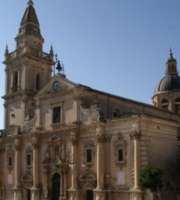Home - In and around
CATHEDRAL OF SAN GIOVANNI BATTISTA IN RAGUSA
The Cathedral of Saint John the Baptist is one of the largest churches of Sicily before the quake stood in the West of the city, beneath the walls of the Castle. The master builders Joseph recovery and John Archdeacon planned the rebuilding in the Baroque style.
Has a Grand fašade, rich in carvings and sculptures, is divided into five parties from large columns on the left side stands the bell tower that rises to over 50 meters. The Interior has a Latin cross plan with apsidal chancel, divided by three wide aisles and fourteen stone pillars ragusan pitch as well as the floor, includes inlays of white limestone, while in 1858 the Serassi organ was constructed with wide wooden choir carved and gilded.
Since 1950, the Church is the seat of the Chair of the Bishop and mother of all the churches of the diocese. The crossing of the transept and the nave, in 1783, was erected the dome which, in the early years of the 20th century, was covered with copper plates, in order to eliminate the harmful seepage of rainwater they were compromising the structure.
In the first half of the nineteenth century the altars of the side aisles originally richly carved and gilded limestone, work of carvers ragusani family Cultraro, are broken up and converted into small chapels, which were places of sober altars in polychrome marble.
source wiki
Has a Grand fašade, rich in carvings and sculptures, is divided into five parties from large columns on the left side stands the bell tower that rises to over 50 meters. The Interior has a Latin cross plan with apsidal chancel, divided by three wide aisles and fourteen stone pillars ragusan pitch as well as the floor, includes inlays of white limestone, while in 1858 the Serassi organ was constructed with wide wooden choir carved and gilded.
Since 1950, the Church is the seat of the Chair of the Bishop and mother of all the churches of the diocese. The crossing of the transept and the nave, in 1783, was erected the dome which, in the early years of the 20th century, was covered with copper plates, in order to eliminate the harmful seepage of rainwater they were compromising the structure.
In the first half of the nineteenth century the altars of the side aisles originally richly carved and gilded limestone, work of carvers ragusani family Cultraro, are broken up and converted into small chapels, which were places of sober altars in polychrome marble.
source wiki



